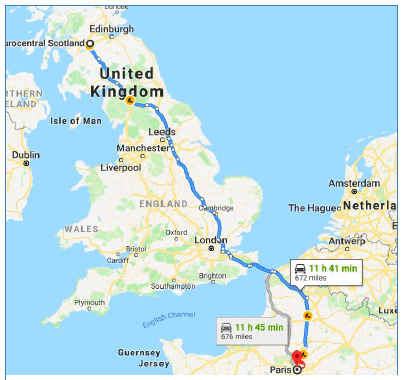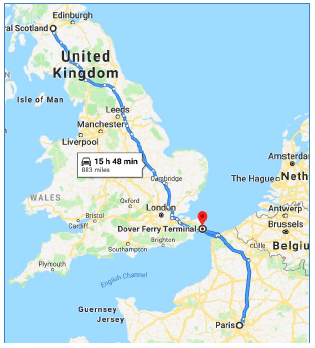Red meat exports: potential administrative costs of trade under WTO rules
This research investigated what the costs will be incurred by Scotland’s red meat export sector when dealing with the EU under World Trade Organisation regulations.
4. Supply Chain Routes and Timings
4.1 Current situation
The large processors based in Scotland operate their own abattoirs and manage their own supply chains and routes to market. They each have different customers in different markets across the EU, many of which are long standing relationships developed and nurtured over several years.
Red meat products are commonly transported by road to the South of England and into the EU via the Channel Tunnel. Most of the lorries travelling to the EU from Scotland will also backhaul products to the UK on their return journey, making the transport costs more efficient overall.
The journey time from Eurocentral to Rungis in Paris via the Channel Tunnel, for example, takes around 11-12 hours and a maximum of 24 hours to reach Southern Europe. To ensure products reach the market as freshly and as quickly as possible, many loads travel overnight.

A typical journey time could be broken down as follows, assuming a pre-embarkation waiting time of 15mins, though that can be variable.
Eurocentral to EuroTunnel 449mins
Wait & embark
15mins
Tunnel crossing
35mins
Disembark
15mins
Calais to Rungis
201mins
715mins
Transit Time
11 hours 55 Minutes
4.2 Supply Chain Routes and Timings – Post-Brexit
If customs and veterinary checks are imposed, waiting times for the freight carriers transporting goods to the EU from Scotland will increase, which will result in increased transportation costs both in terms of labour and running costs.
Increased journey times may also affect the availability of lorries in Scotland, which could lead to order disruption for customers in both domestic and export markets.
Transport operators are concerned about the impact on backhauling. Most of the lorries that travel to Europe with red meat deliveries return full of other goods for delivery in the UK. This provides another income stream for the transport companies and help keeps the outward movement of goods cost-efficient. Like export tariffs, any import tariffs are likely to disrupt trade and have a negative impact in this area. There could be higher freight charges for the red meat businesses using third party logistic providers if there is more uncertainty around backhauling opportunities.
Transport operators are in the process of obtaining the necessary permits to drive in Europe and identifying agents who will be able to assist with paperwork. Industry has raised concerns, however, that the permits may be in short supply.
With several BIPs strategically placed at ports in northern Europe, there is an alternative to the Channel Tunnel route, using ferry operations. Travelling by sea to a different EU entry location than Calais may be viable for some businesses, depending on the end destination for delivery. (Appendix 6 details the sea crossing options between the UK and Europe).
Some of these northern European ports are investing in additional resource to manage an increase in business. (Appendix 5 provides more detail on the Border Inspection Posts).
A change from road to sea makes the route more vulnerable to the weather, which can cause cancellations and delays. The journey by sea also takes longer and there is less flexibility. A typical journey using ferry operations to cross the English Channel will add ~2 hours to the journey, not allowing for delays. Severe delays would increase the risk of fresh meat products being rejected at the BIP, or by the customer, leading to spoilage costs for the Scottish exporter if the meat products cannot be re-directed or used. Such rejection could also impact on the supplier/customer relationship.
The journey time from Eurocentral to Paris via the shortest ferry route, for example, takes around 14 hours.

A breakdown is noted below and shows a total journey time of 13 hours and fifty eight minutes. The total time may vary, however, depending on when the lorry arrives at Dover and how long it has to wait before the ferry departs. Using this route, exporters need to be aware of the maximum hours limits for drivers and try to plan to avoid the lorry needing to park up for a set period mid-route to Dover.
Eurocentral to Dover
457mins
Wait & embark
45mins
Ferry crossing
90mins
Disembark
45mins
Calais to Rungis
201mins
838mins
Transit Time
13 hours 58 Minutes
The transport companies have been preparing for Brexit, including an analysis of alternative shipping routes and the associated challenges, to understand what alternatives exist to the Channel Tunnel.
4.3 Other European Border Crossing Timing Examples[3]
Sweden and Norway – the border between the two countries is cited as being one of the most technologically advanced in the world, where lorries only need to stop once. At the main crossing at Svinesund, estimates suggest that there are ~1,300 lorries every day (less than a 10th of the numbers that pass through Dover). The average waiting time is 20 minutes, which includes 10 minutes waiting time, 3-6 minutes handling time and the time spent coming off the road to complete the process.
Turkey and Bulgaria - Bulgaria is in the EU and Turkey has a Customs Union with the EU for most manufactured goods. The border between the two countries is 167 miles long, served by 3 crossings and queues of lorries are normal. A report prepared for the European Commission in 2014 suggested a waiting time of about 3 hours, however, drivers say that it can be up to 20 hours.
Switzerland and France – the International Road Transport Union reports that the average waiting times at this border can range from 20 minutes to 2 hours if full inspections have to be carried out.
These concerns, and the other, very real non-tariff barriers and challenges facing Scottish red meat exporters, will add a significant burden to the sector post-Brexit. Some can be mitigated, but others will be driven by the established requirements of the EU, if a no deal scenario is the end result. The industry and Public Sector need to be vigilant and alert to the potential damage that could occur, not simply from the obvious tariff implications but from the practicalities of dealing with new and considerable administrative, logistical and resource-hungry practices.
Contact
Email: socialresearch@gov.scot
There is a problem
Thanks for your feedback